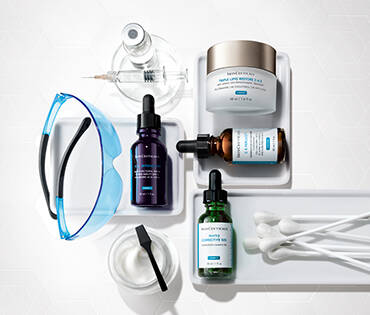ABLATIVE LASER RESURFACING
HELPS ADDRESS:
- Mild to moderate wrinkles
- Skin growths (such as warts)
- Birthmarks
- Liver spots or age spots
- Uneven skin tone
- Sun-damaged skin
- Acne or other scarring
- Stretch marks
- Texture
AVERAGE DOWNTIME: 2-4 weeks, although in some cases skin may appear pink or red for several months post-procedure. Newer fiber “cold” laser technology may decrease downtime considerably depending upon the depth and condition of treated targets.2 FIND A SKINCARE PROFESSIONAL NEAR YOU >
ABLATIVE LASER TREATMENT AT A GLANCE
WHAT IT DOES: An ablative laser functions via an intense heat to vaporize or “ablate” skin cells. During an ablative laser resurfacing, an intense beam of light energy is directed at the specific target on the skin. The laser beam destroys the epidermis or outer layer of the skin while heating the underlying tissue to a temperature capable of denaturing existing collagen and stimulating new collagen production which will develop over time (commonly up to 6 months post-procedure). The result is improved appearance, tone and texture of the skin.
WHAT YOU NEED TO KNOW: Ablative laser skin resurfacing has the potential for some significant social downtime. In some cases the treated areas are bandaged and kept covered for multiple days after the laser treatment. Patients should also be prepared to avoid activities such as gym workouts or environments such as swimming pools where infection is a risk after laser skin resurfacing. It’s important to follow all post-procedure care as instructed by the performing physician, but in general Patients can generally return to work 14 to 21 days following a full field face CO2 ablative laser resurfacing and 3 to 8 days following a full field Er:YAG laser skin resurfacing. Fractional CO2 lasers generally require a 4 to 10 day recovery period, while only 1 to 3 days off work are recommended after fractional Er:YAG laser skin resurfacing.3 Anyone considering ablative laser resurfacing should be informed and prepared to ensure optimal recovery with minimal complications.
Ablative laser, while very effective, may not be an appropriate treatment for some patients with darker skin tones. Because pigment in the skin absorbs more light energy, both ablative laser and non-ablative laser may pose the risk for thermal injury beyond the treated area resulting in damage to the skin and areas of hyperpigmentation. In some cases, clinicians may still safely administer an ablative laser by using lower settings or limiting the number of passes, but that determination should be made by an experienced clinician with a history of success in laser skin resurfacing and laser skin tightening with an ablative laser on darker skin tones.
CHAT WITH A LICENSED AESTHETICIAN NOW >

FEATURED PRODUCT
C E Ferulic
THE CHEMICAL PEEL EXPERIENCE
ABLATIVE LASER FAQS
*Always consult your physician before undergoing this procedure.
POST-TREATMENT SKINCARE ROUTINE
**It is recommended to incorporate an at-home skincare regimen after this procedure; always consult with your physician before using a regimen for individual at-home advice.
***Follow all product use instructions and warnings.
****If irritation occurs, discontinue use; if irritation persists, consult your physician.
DISCOVER PROFESSIONAL TREATMENTS
1https://www.plasticsurgery.org/cosmetic-procedures/laser-skin-resurfacing/cost#:~:text=How%20much%20does%20laser%20skin,not%20include%20other%20related%20expenses.
2https://www.prnewswire.com/news-releases/worlds-first-fda-approved-cold-ablative-fiber-laser-makes-us-debut-301534988.html
3https://www.ncbi.nlm.nih.gov/books/NBK557474/
4https://www.ncbi.nlm.nih.gov/books/NBK557474/
5https://www.biospace.com/article/releases/world-s-first-fda-approved-cold-ablative-fiber-laser-makes-us-debut/
6https://ultraclearlaser.com/
7ablative laser skin resurfacing describes the process of removing the epidermal and superficial dermal layers of the skin to reduce cutaneous signs of photoaging
8https://www.ncbi.nlm.nih.gov/books/NBK557474/





.jpg?sw=370&sh=315&sm=cut&q=70)

.jpg?sw=370&sh=315&sm=cut&q=70)

